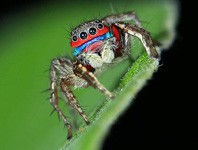Abstract
The genus Synophis contains a number of enigmatic species, distributed primarily in the Andean highlands of northern South America. Their extreme crypsis and rarity has precluded detailed study of most species. A recent flurry of collection activity resulted in the accession of many new specimens, and the description of 4 new species in 2015, doubling the number of described taxa. However, lingering questions remain regarding the assignment of many new and historical specimens, the morphological limits and geographical ranges of the species, and their phylogenetic relationships. We analyze new and existing morphological and molecular data to produce a new molecular phylogeny and revised morphological descriptions. We validate the previously unavailable tribe name Diaphorolepidini Jenner, Pyron, Arteaga, Echevarría, & Torres-Carvajal tribe nov., describe a 9th species Synophis niceforomariae Pyron, Arteaga, Echevarría, & Torres-Carvajal sp. nov., and offer new Standard Names in English and Spanish for the group: Andean Shadow Snakes and Culebras Andinas de la Sombra, respectively. A variety of features such as vertebrae and hemipenes show an interesting range of variation in the group, which should be evaluated in future studies, to refine species limits and diagnoses further. Cryptic and undiscovered diversity undoubtedly remains, and we hope this summary provides a robust basis for future work.
References
Bogert, C.M. (1964) Snakes of the genera Diaphorolepis and Synophis and the colubrid subfamily Xenoderminae. Senckenbergiana Biologica, 45, 509–531.
Boulenger, G.A. (1898) An account of the reptiles and batrachians collected by Mr. Rosenberg, W.F.H., in western Ecuador. Proceedings of the Zoological Society of London, 1898, 107–126.
http://dx.doi.org/10.1111/j.1096-3642.1898.tb03134.xCantino, P.D., de Queiroz, K. (2007) International Code of Phylogenetic Nomenclature. Version 4. Available from: http://www.ohiou.edu/phylocode/ (Accessed 27 Sept. 2016)
Fritts, T.H. & Smith, H.N. (1969) A new genus and species of snake from western Ecuador. Transactions of the Kansas Academy of Science, 72, 60–66.
http://dx.doi.org/10.2307/3627049Grazziotin, F.G., Zaher, H., Murphy, R.W., Scrocchi, G., Benavides, M.A., Zhang, Y.P. & Bonatto, S.L. (2012) Molecular phylogeny of the New World Dipsadidae (Serpentes: Colubroidea): a reappraisal. Cladistics, 28, 437–459.
http://dx.doi.org/10.1111/j.1096-0031.2012.00393.xHillis, D.M. (1990) A new species of xenodontine colubrid snake of the genus Synophis from Ecuador and the phylogeny of the genera Synophis and Emmochliophis. Occasional Papers of the Museum of Natural History, University of Kansas, 135, 1–9.
International Commission on Zoological Nomenclature (1999) International code of zoological nomenclature = Code international de nomenclature zoologique. International Trust for Zoological Nomenclature, London, 306 pp.
Jan, G. (1863) Elenco Sistematico degli Ofidi descriti e disegnati per l'Iconografia Generale. A. Lombardi, Milano, 143 pp.
http://dx.doi.org/10.5962/bhl.title.106683Jenner, J.V. (1981) A zoogeographic study and the taxonomy of the xenodontine snakes. PhD thesis. New York University, New York, 354 pp.
Katoh, K. & Standley, D.M. (2013) MAFFT Multiple Sequence Alignment Software Version 7: Improvements in Performance and Usability. Molecular Biology and Evolution, 30, 772–780.
http://dx.doi.org/10.1093/molbev/mst010Lanfear, R., Calcott, B., Ho, S.Y.W. & Guindon, S. (2012) PartitionFinder: Combined Selection of Partitioning Schemes and Substitution Models for Phylogenetic Analyses. Molecular Biology and Evolution, 29, 1695–1701.
http://dx.doi.org/10.1093/molbev/mss020Martinez, P.M.S. (2011) Comparative anatomy of the tribe Nothopsini (Serpentes, Dipsadidae), Thesis mestrado. Universidade de Sao Paulo, Sao Paulo, 159 pp.
Nicéforo -María, H. (1950) Contribucion al conocimiento de los ofidios de Colombia. Revista de la Academia Colombiana de Ciencias Exactas, Físicas y Naturales, 7, 518–527.
Nicéforo -María, H. (1970) Contribucion al conocimiento de los ofidios de Colombia. Revista de la Academia Colombiana de Ciencias Exactas, Físicas y Naturales, 210, 1–6.
Peracca, M.G. (1896) Nuovo genere di Colubride aglifo dell'America meridionale. Bollettino dei Musei di Zoologia ed Anatomia comparata della R. Università di Torino, 11, 1–2.
Pyron, R.A., Burbrink, F.T., Colli, G.R., de Oca, A.N.M., Vitt, L.J., Kuczynski, C.A. & Wiens, J.J. (2011) The phylogeny of advanced snakes (Colubroidea), with discovery of a new subfamily and comparison of support methods for likelihood trees. Molecular Phylogenetics and Evolution, 58, 329–342.
http://dx.doi.org/10.1016/j.ympev.2010.11.006Pyron, R.A., Burbrink, F.T. & Wiens, J.J. (2013) A phylogeny and revised classification of Squamata, including 4161 species of lizards and snakes. Bmc Evolutionary Biology, 13, 93.
http://dx.doi.org/10.1186/1471-2148-13-93Pyron, R.A., Guayasamin, J.M., Penafiel, N., Bustamante, L. & Arteaga, A. (2015) Systematics of Nothopsini (Serpentes, Dipsadidae), with a new species of Synophis from the Pacific Andean slopes of southwestern Ecuador. Zookeys, 109–147.
http://dx.doi.org/10.3897/zookeys.541.6058Rodriguez, G. (2002) El naturalista Antoine Rouhaire (Hermano Nicéforo María) y el desarrollo de zoología sistemática en Colombia. Revista de la Academia Colombiana de Ciencias Exactas, Físicas y Naturales, 26, 229–238.
Ronquist, F., Teslenko, M., van der Mark, P., Ayres, D.L., Darling, A., Hohna, S., Larget, B., Liu, L., Suchard, M.A. & Huelsenbeck, J.P. (2012) MrBayes 3.2: Efficient Bayesian Phylogenetic Inference and Model Choice Across a Large Model Space. Systematic Biology, 61, 539–542.
http://dx.doi.org/10.1093/sysbio/sys029Savitzky, A.H. (1974) The relationships of the xenodontine colubrid snakes related to Ninia. MS thesis. University of Kansas, Lawrence, Kansas, 64 pp.
Sheil, C.A. (1998) Emmochliophis miops: Redescription of Synophis miops (Boulenger, 1898). Journal of Herpetology, 32, 604–607.
http://dx.doi.org/10.2307/1565222Sheil, C.A. & Grant, T. (2001) A new species of colubrid snake (Synophis) from western Colombia. Journal of Herpetology, 35, 204–209.
http://dx.doi.org/10.2307/1566109Society for the Study of Amphibians and Reptiles. & Adler, K. (1989) Contributions to the history of herpetology. S.S.A.R., Oxford, Ohio, 202 pp.
Torres-Carvajal, O., Echevarría, L.Y., Venegas, P.J., Chávez, G. & Camper, J.D. (2015) Description and phylogeny of three new species of Synophis (Colubridae, Dipsadinae) from the tropical Andes in Ecuador and Peru. Zookeys, 153–179.
http://dx.doi.org/10.3897/zookeys.546.6533Vidal, N., Delmas, A.S., David, P., Cruaud, C., Coujoux, A. & Hedges, S.B. (2007) The phylogeny and classification of caenophidian snakes inferred from seven nuclear protein-coding genes. Comptes Rendus Biologies, 330, 182–187.
http://dx.doi.org/10.1016/j.crvi.2006.10.001Wrobel, M. (2004) Elsevier's dictionary of reptiles: in Latin, English, German, French and Italian. Elsevier, Amsterdam; Oxford, 758 pp.
Zaher, H. (1999) Hemipenial morphology of the South American xenodontine snakes, with a proposal for a monophyletic Xenodontinae and a reappraisal of colubroid hemipenes. Bulletin of the American Museum of Natural History, 1–168.
Zaher, H., Grazziotin, F.G., Cadle, J.E., Murphy, R.W., de Moura, J.C. & Bonatto, S.L. (2009) Molecular phylogeny of advanced snakes (Serpentes, Caenophidia) with an emphasis on South American Xenodontines: a revised classification and descriptions of new taxa. Papeis Avulsos de Zoologia, 49, 115–153.
http://dx.doi.org/10.1590/S0031-10492009001100001

